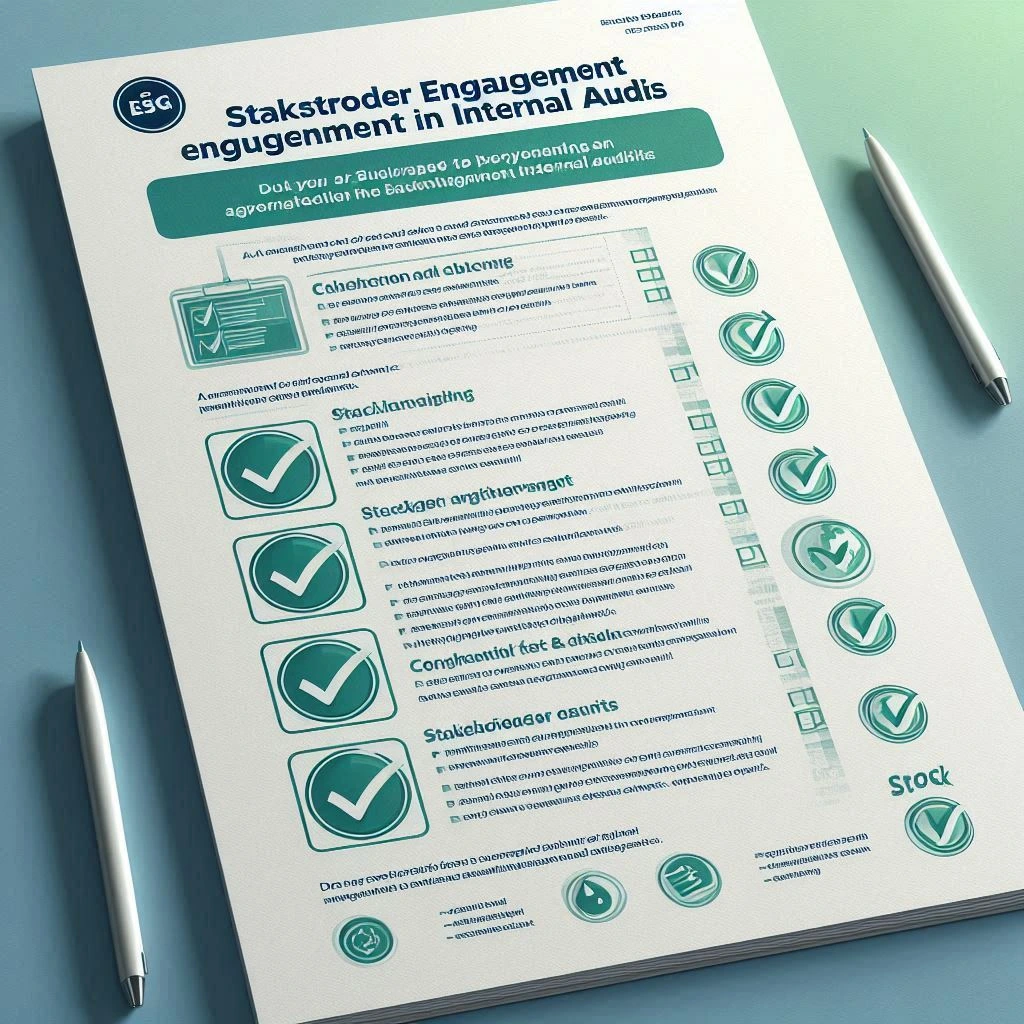In recent years, the concept of ESG—Environmental, Social, and Governance—has gained significant traction among organizations striving for sustainable and responsible business practices. ESG criteria serve as a framework for evaluating a company’s operations and their impact on the environment, society, and governance structures. Utilizing an ESG risk assessment template can be particularly beneficial. Understanding these principles is crucial for internal auditors and stakeholder engagement professionals as they navigate the complexities of ESG compliance.
Definition of ESG Criteria: ESG encompasses three key areas:
- Environmental: This aspect evaluates how a company performs as a steward of nature. It includes considerations such as carbon emissions, waste management, and resource conservation.
- Social: This dimension assesses how a company manages relationships with employees, suppliers, customers, and the communities where it operates. It includes labor practices, community engagement, and human rights.
- Governance: This area focuses on a company’s leadership, executive pay, audits, internal controls, and shareholder rights. It ensures that the organization operates with transparency and accountability.
Importance of Stakeholder Engagement: Engaging stakeholders is vital for the success of ESG initiatives. Stakeholders—including investors, employees, customers, suppliers, and the broader community—play a crucial role in shaping and supporting ESG strategies. Their insights and feedback can help organizations identify risks, enhance transparency, and foster trust. Effective stakeholder engagement not only drives ESG compliance but also contributes to the overall sustainability and reputation of the organization.
Role of Internal Audit in Assessing ESG Compliance: Internal auditors are uniquely positioned to assess and enhance ESG compliance within organizations. They can provide independent evaluations of ESG practices, ensuring that the company adheres to relevant standards and regulations. By integrating ESG considerations into the internal audit process, auditors can help identify gaps in compliance, recommend improvements, and ensure that stakeholder concerns are addressed. This proactive approach not only strengthens the organization’s ESG framework but also enhances stakeholder confidence in its commitment to sustainable practices.
The integration of ESG principles into internal audits, coupled with robust stakeholder engagement, is essential for organizations aiming to achieve compliance and drive meaningful change. By leveraging an ESG checklist, internal auditors can systematically evaluate and enhance their organization’s ESG initiatives, ensuring that they align with stakeholder expectations and contribute to long-term sustainability.
Understanding Stakeholders in the ESG Context
In the realm of Environmental, Social, and Governance (ESG) audits, stakeholder engagement is crucial for ensuring that the audit process is comprehensive and reflective of diverse perspectives. This section aims to identify and categorize the key stakeholders involved in the ESG audit process, emphasizing their roles and the importance of their input.
Types of Stakeholders
Internal Stakeholders:
- Management: They play a pivotal role in setting the strategic direction for ESG initiatives and ensuring alignment with corporate goals. Their insights are essential for understanding the organization’s priorities and challenges related to ESG compliance.
- Employees: As the backbone of any organization, employees can provide valuable feedback on the company’s ESG practices. Their engagement is vital for fostering a culture of sustainability and social responsibility within the organization.
External Stakeholders:
- Investors: They are increasingly focused on ESG performance as part of their investment criteria. Engaging with investors helps organizations understand market expectations and the potential impact of ESG factors on financial performance.
- Regulators: Compliance with regulatory requirements is a key aspect of ESG audits. Engaging with regulators ensures that the organization is aware of the latest standards and can adapt its practices accordingly.
- Community: Local communities are directly affected by a company’s operations. Their perspectives can provide insights into social impacts and help shape more responsible corporate behavior.
Importance of Stakeholder Perspectives
Incorporating stakeholder perspectives is essential for shaping effective ESG goals. Stakeholders can offer unique insights that help identify risks and opportunities related to ESG factors. By understanding their concerns and expectations, organizations can develop more robust ESG strategies that align with stakeholder values and enhance overall corporate reputation. This engagement not only fosters trust but also encourages collaboration, leading to more sustainable outcomes.
Methods for Identifying and Mapping Stakeholders
To effectively engage stakeholders in the ESG audit process, organizations can employ several methods for identification and mapping:
- Stakeholder Analysis: This involves identifying all potential stakeholders and assessing their influence and interest in ESG issues. Tools such as power-interest grids can help categorize stakeholders based on their level of influence and concern.
- Surveys and Interviews: Conducting surveys or interviews with stakeholders can provide direct insights into their perspectives on ESG practices. This qualitative data is invaluable for understanding stakeholder priorities and concerns.
- Workshops and Focus Groups: Organizing workshops or focus groups can facilitate open discussions among stakeholders, allowing for a deeper exploration of ESG issues and collaborative problem-solving.
- Regular Communication: Establishing channels for ongoing communication with stakeholders ensures that their views are continuously considered throughout the ESG audit process.
By effectively identifying and engaging stakeholders, internal auditors can enhance the quality and relevance of ESG audits, ultimately leading to more informed decision-making and improved ESG performance.
Developing an Effective ESG Checklist for Stakeholder Engagement
In the realm of internal audits, particularly concerning Environmental, Social, and Governance (ESG) factors, stakeholder engagement is paramount. A well-structured ESG checklist can facilitate this engagement, ensuring that all relevant voices are heard and considered throughout the audit process. Below is a comprehensive checklist designed for internal auditors to enhance stakeholder engagement effectively.
1. Creating a Preliminary List of Stakeholders
- Identify Key Stakeholders: Begin by compiling a list of all potential stakeholders involved in or affected by the ESG audit. This may include employees, management, investors, suppliers, customers, and community representatives.
- Categorize Stakeholders: Group stakeholders based on their relationship to the organization and the ESG issues at hand. This helps in prioritizing engagement efforts.
2. Assessing the Interests and Influence of Each Stakeholder
- Interest Mapping: Evaluate what specific ESG issues matter most to each stakeholder. Understanding their interests will guide the engagement process.
- Influence Assessment: Determine the level of influence each stakeholder has on the audit process and outcomes. This can help in strategizing how to engage them effectively.
3. Engagement Strategies
- Communication Methods: Develop tailored communication strategies for different stakeholder groups. This could include emails, newsletters, meetings, or workshops, depending on the stakeholders’ preferences and the complexity of the information.
- Meeting Frequency: Establish a schedule for regular meetings or updates. Consistent communication fosters trust and keeps stakeholders informed about the audit’s progress.
- Feedback Loops: Create mechanisms for stakeholders to provide feedback throughout the audit process. This could involve surveys, suggestion boxes, or dedicated feedback sessions.
4. Incorporating Stakeholder Input into the ESG Audit Process
- Integrate Feedback: Actively incorporate stakeholder feedback into the audit findings and recommendations. This not only enhances the audit’s relevance but also demonstrates that stakeholder voices are valued.
- Report Back: After the audit, share the outcomes with stakeholders, highlighting how their input influenced the process. This transparency builds credibility and encourages future engagement.
By following this structured checklist, internal auditors can ensure that stakeholder engagement is not just a formality but a meaningful part of the ESG audit process. Engaging stakeholders effectively not only enriches the audit findings but also strengthens the organization’s commitment to sustainability and social responsibility.
Integrating the ESG Checklist into the Internal Audit Process
Incorporating an ESG (Environmental, Social, and Governance) checklist into the internal audit process is essential for enhancing stakeholder engagement and ensuring that audits are comprehensive and aligned with corporate sustainability goals. Here are key points on how to effectively integrate the ESG checklist into existing internal audit frameworks:
- Aligning the ESG Checklist with the Internal Audit Plan: The first step in integrating the ESG checklist is to ensure that it aligns with the overall internal audit plan. This involves reviewing the audit objectives and determining how ESG factors can be incorporated into the audit scope. By doing so, auditors can ensure that ESG considerations are not treated as an afterthought but are embedded in the audit strategy from the outset. This alignment helps in identifying relevant ESG risks and opportunities that may impact the organization’s performance and reputation [2][5].
- Utilizing the Checklist During Risk Assessments and Audit Reviews: The ESG checklist should be utilized during risk assessments to identify potential ESG-related risks that could affect the organization. This includes evaluating the company’s policies, operations, and stakeholder interactions concerning environmental impact, social responsibility, and governance practices. By integrating ESG criteria into risk assessments, internal auditors can provide a more holistic view of the organization’s risk landscape and ensure that ESG risks are given the same level of attention as traditional financial risks [3][9]. Additionally, during audit reviews, the checklist can serve as a guide to evaluate the effectiveness of existing ESG initiatives and compliance with relevant standards [5][8].
- Documenting Stakeholder Engagement Efforts and Outcomes: Effective stakeholder engagement is crucial for a successful ESG audit. Internal auditors should document their engagement efforts with stakeholders, including how concerns were addressed and the outcomes of these interactions. This documentation not only provides transparency but also helps in building trust with stakeholders. It is important to capture feedback from stakeholders regarding ESG initiatives and to assess how these insights can inform future audits and corporate strategies [1][4]. By maintaining thorough records of stakeholder engagement, auditors can demonstrate the organization’s commitment to ESG principles and enhance the credibility of their audit findings [6][8].
Integrating an ESG checklist into the internal audit process is vital for fostering stakeholder engagement and ensuring that ESG risks are adequately addressed. By aligning the checklist with the internal audit plan, utilizing it during risk assessments, and documenting stakeholder interactions, internal auditors can enhance the effectiveness of their audits and contribute to the organization’s sustainability objectives.
Best Practices for Engaging Stakeholders in ESG Audits
Engaging stakeholders effectively during the ESG audit process is crucial for ensuring compliance, building trust, and driving meaningful change. Here are some best practices that internal auditors and stakeholder engagement professionals can implement to foster effective stakeholder engagement:
- Building Trust and Transparency with Stakeholders: Open and honest communication about ESG policies, practices, and outcomes is essential. This transparency not only ensures compliance but also cultivates trust among stakeholders, which is vital for a successful audit process [1]. Regular updates and clear reporting on ESG performance can help reinforce this trust.
- Encouraging Open Dialogue and Active Participation: Actively involving stakeholders—such as employees, investors, customers, and local communities—throughout the ESG audit process is key to success. This can be achieved by organizing regular meetings and consultations, allowing stakeholders to voice their concerns and suggestions [2][3]. Such engagement fosters a collaborative environment where stakeholders feel valued and invested in the audit outcomes.
- Leveraging Technology for Stakeholder Engagement: Utilizing technology can enhance stakeholder engagement significantly. Tools such as online surveys and dedicated platforms for feedback can facilitate communication and gather insights from a broader audience. This approach not only streamlines the engagement process but also allows for real-time feedback, making it easier to address stakeholder concerns promptly [4].
- Monitoring and Evaluating Stakeholder Engagement Effectiveness: It is important to regularly review and assess the effectiveness of stakeholder engagement strategies. This includes tracking participation rates, gathering feedback on the engagement process, and making necessary adjustments based on stakeholder input. Continuous improvement in engagement practices can lead to more effective audits and stronger relationships with stakeholders [5][8].
By implementing these best practices, internal auditors can enhance stakeholder engagement in ESG audits, ultimately leading to more comprehensive and effective audit outcomes. Engaging stakeholders not only fulfills regulatory requirements but also serves as a valuable opportunity to build trust and drive meaningful change within the organization [9].
Examples of Successful Stakeholder Engagement in ESG
In the realm of Environmental, Social, and Governance (ESG) audits, stakeholder engagement plays a pivotal role in ensuring that the audit process is comprehensive, transparent, and effective. By examining real-world examples, we can glean valuable insights into how organizations have successfully engaged stakeholders and the positive impact this has had on their ESG audit outcomes.
Organizations Successfully Engaging Stakeholders
Unilever: As a global leader in consumer goods, Unilever has made significant strides in sustainability. The company actively involves stakeholders in its ESG initiatives, ensuring that their concerns and insights shape its sustainability strategies. This engagement has not only enhanced Unilever’s reputation but also improved its operational efficiencies and product offerings, aligning them with stakeholder expectations [4].
VAUDE: This outdoor apparel company is known for its commitment to sustainability and social responsibility. VAUDE engages stakeholders through regular consultations and feedback mechanisms, which inform their ESG practices. This proactive approach has led to innovative solutions that address both environmental and social challenges, demonstrating the effectiveness of stakeholder involvement in shaping ESG outcomes.
Royal BAM Group: This construction and engineering company has integrated stakeholder engagement into its ESG audit processes by establishing clear communication channels with local communities, clients, and employees. By prioritizing stakeholder input, BAM Group has been able to identify potential risks and opportunities, leading to more informed decision-making and enhanced project outcomes.
Analyzing the Impact of Engagement on ESG Audit Outcomes
The engagement of stakeholders in ESG audits has shown to significantly influence the effectiveness of the audit process. Key impacts include:
- Enhanced Transparency: Engaging stakeholders fosters a culture of transparency, where organizations are more accountable for their ESG practices. This transparency is crucial for building trust with stakeholders, including investors, customers, and regulators [14].
- Improved Risk Management: By involving stakeholders, organizations can better identify and assess risks related to ESG factors. This comprehensive understanding allows for more effective risk mitigation strategies, ultimately leading to better audit outcomes.
- Informed Decision-Making: Stakeholder insights provide valuable context that can inform strategic decisions. Organizations that actively seek stakeholder feedback are better positioned to align their ESG initiatives with stakeholder expectations, resulting in more relevant and impactful audit findings.
Lessons Learned and Recommendations
From the case studies examined, several key lessons and recommendations emerge for internal auditors and stakeholder engagement professionals:
- Prioritize Stakeholder Mapping: Conduct a thorough stakeholder mapping exercise to identify key stakeholders and understand their concerns. This foundational step is critical for effective engagement and should be revisited regularly to adapt to changing dynamics [11].
- Establish Clear Communication Channels: Develop and maintain open lines of communication with stakeholders. Regular updates and feedback sessions can help ensure that stakeholders feel valued and heard, fostering a collaborative environment [14].
- Integrate Stakeholder Feedback into Audit Processes: Actively incorporate stakeholder insights into the ESG audit framework. This integration can enhance the relevance and effectiveness of the audit, leading to more actionable outcomes.
- Document and Share Best Practices: Organizations should document their stakeholder engagement processes and outcomes, sharing these insights with peers. This practice not only promotes transparency but also encourages continuous improvement in ESG audit practices across the industry.
Effective stakeholder engagement is essential for successful ESG audits. By learning from organizations that have excelled in this area, internal auditors can enhance their audit processes, ultimately leading to more robust and impactful ESG outcomes.
Challenges in Stakeholder Engagement during ESG Audits
Engaging stakeholders effectively during Environmental, Social, and Governance (ESG) audits is crucial for ensuring comprehensive and accurate reporting. However, internal auditors often face several challenges that can hinder this engagement. Below are some common obstacles and strategies to overcome them, along with the importance of adaptability and continuous improvement in these efforts.
Common Challenges in Stakeholder Engagement
- Resistance to Change: Stakeholders may be resistant to new processes or changes in reporting practices. This resistance can stem from a lack of understanding of the ESG framework or fear of increased scrutiny [5].
- Lack of Interest: Some stakeholders may not see the relevance of ESG audits to their roles or responsibilities, leading to disengagement. This can be particularly pronounced in organizations where ESG initiatives are not prioritized.
- Diverse Interests and Expectations: Different stakeholders often have varying interests and expectations regarding ESG outcomes. This diversity can complicate the engagement process, as aligning these interests is essential for effective collaboration [9].
- Data Integrity Issues: Ensuring the accuracy and reliability of data collected from stakeholders can be challenging. Disparate systems and outdated methods can lead to inconsistencies that undermine stakeholder trust [2][4].
- Feedback Mechanisms: Establishing effective channels for stakeholders to share their opinions and feedback can be difficult. Without these mechanisms, stakeholders may feel their voices are not heard, leading to further disengagement [1].
Strategies for Overcoming Engagement Barriers
- Education and Training: Providing stakeholders with training on the importance of ESG audits and how they impact the organization can help mitigate resistance and foster interest. This can include workshops, informational sessions, and resources that clarify the benefits of ESG initiatives [5].
- Tailored Communication: Developing communication strategies that address the specific interests and concerns of different stakeholder groups can enhance engagement. This may involve personalized outreach or targeted messaging that resonates with their unique perspectives [9].
- Involvement in the Process: Actively involving stakeholders in the audit process can increase their investment in the outcomes. This could include soliciting their input during the planning stages or inviting them to participate in discussions about findings and recommendations [6].
- Utilizing Technology: Implementing modern tools and platforms for data collection and feedback can streamline the engagement process. This can help ensure data integrity and make it easier for stakeholders to participate [4].
Importance of Adaptability and Continuous Improvement
The landscape of ESG reporting is constantly evolving, and so too must the strategies for stakeholder engagement. Internal auditors should prioritize adaptability in their approaches, regularly assessing the effectiveness of their engagement efforts and making necessary adjustments. Continuous improvement can be achieved through:
- Regular Feedback Loops: Establishing mechanisms for ongoing feedback from stakeholders can help identify areas for improvement and foster a culture of collaboration [1].
- Monitoring Trends: Keeping abreast of emerging trends in ESG reporting and stakeholder expectations can inform engagement strategies and ensure they remain relevant [8].
- Iterative Learning: Embracing a mindset of learning from past audits and stakeholder interactions can lead to more effective engagement strategies in future audits [6].
By addressing these challenges and implementing effective strategies, internal auditors can enhance stakeholder engagement during ESG audits, ultimately leading to more robust and credible reporting.
Conclusion: The Future of ESG Audits and Stakeholder Engagement
As the landscape of corporate responsibility continues to evolve, the significance of an ESG checklist in the internal audit process cannot be overstated. This checklist serves as a vital tool for internal auditors, enabling them to systematically evaluate an organization’s environmental, social, and governance practices. By utilizing this checklist, auditors can ensure that they are addressing the critical areas of risk and compliance, which are increasingly scrutinized by stakeholders and regulatory bodies alike [5][7].
Key Takeaways:
- Importance of the ESG Checklist: The ESG checklist is essential for identifying and assessing the various risks associated with environmental, social, and governance factors. It provides a structured approach to evaluating an organization’s practices and helps in verifying the accuracy of ESG-related data disclosed to stakeholders [4][5]. This systematic evaluation not only enhances transparency but also builds trust with stakeholders, which is crucial in today’s business environment.
- Prioritizing Stakeholder Engagement: Engaging stakeholders throughout the ESG audit process is paramount. Internal auditors should actively seek stakeholder views and integrate their feedback into the audit framework. This engagement not only helps in understanding stakeholder concerns but also aligns the audit process with the expectations of those who are impacted by the organization’s operations [1][6]. By prioritizing stakeholder engagement, auditors can foster a collaborative environment that enhances the effectiveness of the audit and promotes a culture of accountability.
- Looking Ahead: Trends in ESG Audits and Stakeholder Involvement: The future of ESG audits will likely see an increased emphasis on stakeholder involvement. As organizations face growing pressure to demonstrate their commitment to sustainability and social responsibility, the role of stakeholders in shaping ESG strategies will become even more critical. Trends indicate that companies will need to adopt more inclusive approaches, integrating stakeholder feedback into their ESG frameworks and reporting processes [2][8]. This shift will not only improve the quality of ESG audits but also enhance the overall credibility of the organization’s sustainability efforts.
In conclusion, the ongoing importance of stakeholder engagement in ESG audits cannot be overlooked. As internal auditors, embracing this engagement will not only strengthen the audit process but also contribute to a more sustainable and responsible business model. By leveraging the ESG checklist and prioritizing stakeholder involvement, organizations can navigate the complexities of ESG compliance and build a resilient future.
Find out more about Shaun Stoltz https://www.shaunstoltz.com/about/
This post was written by an AI and reviewed/edited by a human.



